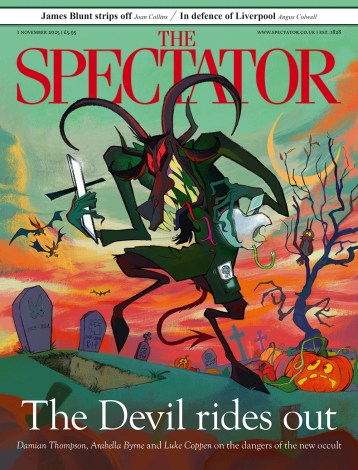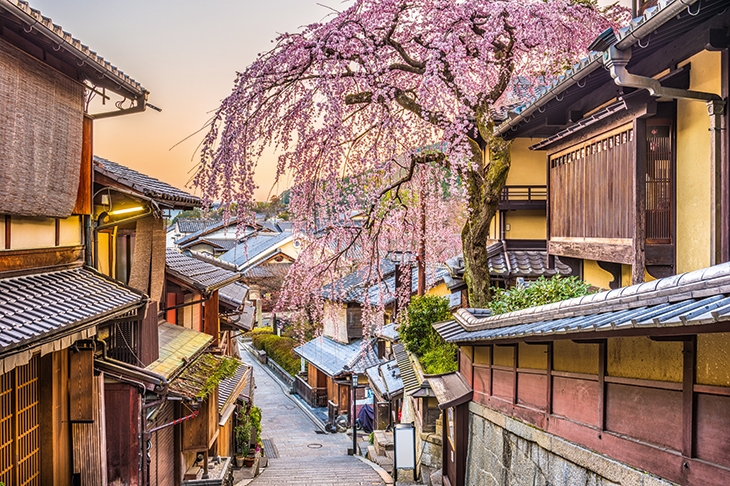Between 1639 and 1853, seeds and scions of flowering cherry trees travelled across Japan to Edo (present-day Tokyo). Each came from the most beautiful specimens of varieties of tree from the different principalities of Japan. From mountainous regions came the light pink yama-zakura; from the chilly climates of Hokkaido and northern Honshu came the crimson Ohyama-zakura; Mame-zakura, with their neat skirt-like white petals, came from Mount Fuji; and the rainy Izu islands produced Oshima cherries, with large, white flowers.
This was an era of peace. For centuries before, the various families of Japan had fought for power. Now, they all answered to a single family, the Tokugawa family, in Edo, where each lord was required to have a residence. Almost all lords brought cherries — wild and cultivated — from their principalities with them. And so in Edo gardens — in varying blossom colours, petal numbers and tree shapes — Japan’s diverse cultures, traditions, climates and peoples were represented and celebrated. For months at a time, blossoms of the different varieties, which each bloomed at different times of the year, would put on colourful displays.
Today, however, Tokyo’s cherry trees are known for their synchronous blossoming. Along the Arakawa River, great rows of trees turn pink for eight days only, each April. In unison, here and elsewhere in Japan, their blossoms bloom and then die quickly, symbolising the beauty and fleeting transience of life. The cherry trees of contemporary Japan are not a diverse mix. They are mostly just one species — the somei-yoshino, a cultivated variety with single pink blossoms that bloom on bare branches.
Naoko Abe concerns herself with two things in this book, first published in 2016 in Japanese. She investigates how, when and why this change took place; and she traces the life and work of an English ornithologist-turned-cherry-tree-specialist, Collingwood Ingram, born in 1880, who was responsible for saving many of the varieties of Japanese cherry that would otherwise probably have become extinct.
Abe describes the strange place Japan occupies in western history. It was ‘discovered’ in the 13th century by Marco Polo; the 16th century saw its first contact with the West and, consequently, with guns and Catholicism; it ‘avoided colonisation’ by closing its gates to all foreigners during the Sakoku era (when lords brought cherries to Edo); and then reopened for trade in 1853, after American ships held a town hostage with their cannons. A period — the Meiji era — of fast industrialisation and westernisation followed. It was during this time that Ingram, a man born into huge wealth — his grand-father, Herbert, founded the Illustrated London News — developed a curiosity about Japan, whose flora and fauna he had read about in books in his family home in Westgate-on-Sea.
Ingram travelled to Japan in 1902 and 1904, noting with awe that there ‘man adds to, instead of detracts from, the beauty of his country’. In 1926, he visited for one last time, with the intention of collecting scions and seeds of the diverse species of cherry trees he had witnessed bloom on his earlier trips, for his garden in Kent.
Abe demonstrates how uniquely well-placed Ingram was, as a cherry-collector, to recognise dangerous changes taking place in Japanese politics. In the 1920s–30s, cherry trees killed by the Great Kanto Earthquake, and pollution, were replaced with just a single variety, the fast-growing somei-yoshino, partly due to this species’ hardiness and partly as a method of propaganda. In the lead up to and during the second world war, emphasis was placed on the short flowering life of the increasingly abundant somei-yoshino, so that the cherry blossom — once the mark of a peaceful, diverse people — became a symbol of a conforming, unified population, willing to die for the emperor. While many cherry species began to die out in Japan, individualism and free speech were suppressed and restricted, too.
Ingram’s mission became an urgent one. Foreseeing the extinction of numerous varieties — caused by dangerous ideologies that would lead to the assassination of the prime minister, militarisation and war — he collected scions and seeds of as many remaining species as he could and sent them to his home, the Grange, in Benenden, where he created a nursery. Over the next decades, he carefully tended to more than 100 varieties.
Like the short-lived blossoms of the somei-yoshino, young Japanese men were expected to bloom and fall for the emperor during the war. Abe includes poems written by young Kamikaze pilots before their suicide flights (‘As a young cherry/ Life is most worthy when falling’) and describes Kamikaze planes adorned with images of blossoms. The symbol of the cherry was used to ‘glorify and beautify’ the deaths of men, many of whom were still teenagers.
Crucially, Abe includes an interview with the grandson of a woman, Tome Torihama, who owned a restaurant designated as a break place for training Kamikaze pilots.He explains how his grandmother described the pilots as having been ‘in great agony and afraid to die’, often arriving at the restaurant injured after being beaten up during training. While they wrote cherry blossom poems during their final days to be sent home via official, censored routes, many posted letters home secretly through Torihama that expressed fear and unwillingness to sacrifice themselves (something then considered treason). Abe says this ‘cherry ideology’, as she calls it, ‘caused the deaths of millions’. One of Ingram’s own family members, his daughter-in-law, was a victim of it; in Hong Kong, she was held in a notorious camp as a POW.
In England, Ingram headed Benenden’s Home Guard and cared for his cherry trees. In Japan, some remaining sakuramori, or ‘cherry guardians’ — the Japanese word for people who collected and protected cherry trees — struggled to maintain their collections of rare varieties (a treasonous activity) during the war. The 15th of a line of sakuramori, Toemon Sano, risked his life to protect a small selection of the rarest varieties, including one that Ingram had reintroduced to Japan just before the war; scions of the Taihaku (Great White), named after its huge white blossoms, were repeatedly sent by Ingram to Sano and another sakuramori, Masuhiko Kayama, but perished each time in transit. Finally, in 1932, one was dispatched embedded in a potato, and arrived alive. ‘Your blossoms are a chain of friendship/ Between England and Japan,’ read lines of a poem by Kayama. During the war, efforts to preserve species of cherry in both England and Japan read like efforts to preserve friendship — and the symbol of diversity and peace that the cherry tree once was — through desperate times.
This deeply moving book — beautifully written, and a huge achievement in terms of research — records the developments of Abe’s own understanding of the histories of two countries, both significant to her. After the war, Ingram published Ornamental Cherries, widely considered the definitive book on flowering cherry trees, with an inscription: ‘For all who have planted cherry trees, whatever their creed, caste or colour may be.’ Both it and Abe’s book carry a torch for peace and diversity of both ecosystems and people.






Comments